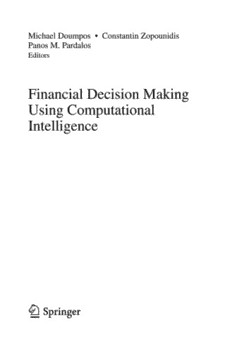
Financial Decision Making Using Computational Intelligence PDF
Preview Financial Decision Making Using Computational Intelligence
Springer Optimization and Its Applications VOLUME70 ManagingEditor PanosM.Pardalos(UniversityofFlorida) Editor–CombinatorialOptimization Ding-ZhuDu(UniversityofTexasatDallas) AdvisoryBoard J.Birge(UniversityofChicago) C.A.Floudas(PrincetonUniversity) F.Giannessi(UniversityofPisa) H.D.Sherali(VirginiaPolytechnicandStateUniversity) T.Terlaky(LehighUniversity) Y.Ye(StanfordUniversity) AimsandScope Optimization has been expanding in all directions at an astonishing rate during the last few decades. New algorithmic and theoretical techniques havebeendeveloped,thediffusionintootherdisciplineshasproceededata rapidpace,andourknowledgeofallaspectsofthefieldhasgrownevenmore profound.Atthe sametime, oneofthe moststriking trendsin optimization is the constantly increasing emphasis on the interdisciplinary nature of the field.Optimizationhasbeenabasictoolinallareasofappliedmathematics, engineering,medicine,economics,andothersciences. The series Springer Optimization and Its Applications publishes under- graduate and graduate textbooks, monographs and state-of-the-art exposi- tory work that focus on algorithms for solving optimization problems and alsostudyapplicationsinvolvingsuchproblems.Someofthetopicscovered include nonlinear optimization (convex and nonconvex), network flow problems, stochastic optimization, optimal control, discrete optimization, multi-objectiveprogramming,descriptionofsoftwarepackages,approxima- tiontechniquesandheuristicapproaches. Forfurthervolumes: http://www.springer.com/series/7393 Michael Doumpos • Constantin Zopounidis Panos M. Pardalos Editors Financial Decision Making Using Computational Intelligence 123 Editors MichaelDoumpos ConstantinZopounidis DepartmentofProduction DepartmentofProduction Engineering&Management Engineering&Management TechnicalUniversityofCrete TechnicalUniversityofCrete UniversityCampus UniversityCampus Chania,Greece Chania,Greece PanosM.Pardalos CenterforAppliedOptimization ISEDepartment UniversityofFlorida Gainesville,FL,USA and LaboratoryofAlgorithms andTechnologiesforNetworks Analysis(LATNA) NationalResearchUniversity HigherSchoolofEconomics Moscow,Russia ISSN1931-6828 ISBN978-1-4614-3772-7 ISBN978-1-4614-3773-4(eBook) DOI10.1007/978-1-4614-3773-4 SpringerNewYorkHeidelbergDordrechtLondon LibraryofCongressControlNumber:2012942084 ©SpringerScience+BusinessMediaNewYork2012 Thisworkissubjecttocopyright.AllrightsarereservedbythePublisher,whetherthewholeorpartof thematerialisconcerned,specificallytherightsoftranslation,reprinting,reuseofillustrations,recitation, broadcasting,reproductiononmicrofilmsorinanyotherphysicalway,andtransmissionorinformation storageandretrieval,electronicadaptation,computersoftware,orbysimilarordissimilarmethodology nowknownorhereafterdeveloped.Exemptedfromthislegalreservationarebriefexcerptsinconnection with reviews or scholarly analysis or material supplied specifically for the purpose of being entered and executed on a computer system, for exclusive use by the purchaser of the work. Duplication of this publication or parts thereof is permitted only under the provisions of the Copyright Law of the Publisher’slocation,initscurrentversion,andpermissionforusemustalwaysbeobtainedfromSpringer. PermissionsforusemaybeobtainedthroughRightsLinkattheCopyrightClearanceCenter.Violations areliabletoprosecutionundertherespectiveCopyrightLaw. Theuseofgeneraldescriptivenames,registerednames,trademarks,servicemarks,etc.inthispublication doesnotimply,evenintheabsenceofaspecificstatement,thatsuchnamesareexemptfromtherelevant protectivelawsandregulationsandthereforefreeforgeneraluse. While the advice and information in this book are believed to be true and accurate at the date of publication,neithertheauthorsnortheeditorsnorthepublishercanacceptanylegalresponsibilityfor anyerrorsoromissionsthatmaybemade.Thepublishermakesnowarranty,expressorimplied,with respecttothematerialcontainedherein. Printedonacid-freepaper SpringerispartofSpringerScience+BusinessMedia(www.springer.com) Fastis fine, butaccuracy is everything. Xenophon(Greekhistorian,431–350BC) Preface TheContextof FinancialDecision Making At the beginning of the twentieth century, finance was mainly a descriptive science focusingon institutionaland legalaspects [9], but since then the field has experiencedmajortransformations.Thesetransformationsbeganduringthe1950s withthepioneeringworkofHarryMarkowitzonportfoliotheory[7]andintensified after then in the 1970swith the work of Black and Scholeson optionpricing [1]. With these breakthroughs, the descriptive character of financial theory gradually progressed towards a more analytic one, which ultimately led to the engineering phaseoffinancebythelate1980s[8]. Todays,the financialindustryis goingthrougha toughperiodcharacterizedby increasinguncertaintiesandriskchallengesofdiversenature.Theglobalizationof the business environment has generated several new opportunities and increased the pace of development for many financial instruments and innovations. In this context, investors have a wide range of options suitable for different investment policies. Managers of firms can use a variety of products for corporate financing andriskmanagement,andpolicymakersfacenewchallengesinchoosingthebest policies and measures for monitoring and controlling the markets in an effective way.Clearly,thedecision-makingprocessinthe“newera”offinanceisbecoming more and more difficult, as all stakeholders seek effective operational decision- supporttoolstoassessrisks,assets,andfunds,takingintoparticularconsideration thenewissuesandconcernsraisedbytherecentglobalcrisis. Thefinancialdecisionsinfirmsandorganizationareofdiversenature,involving investmentappraisal,riskmanagement,assetvaluation,capitalbudgeting,corporate financing,andperformanceevaluationamongothers.Dependingontheproblemat hand,differentmodelingandmethodologiesareapplicable,suchas: • Regressionmodelsforriskanalysis • Econometricmethodsfortime-seriesforecasting • Stochasticcalculusforassetpricing • Optimizationtechniquesforassetallocation vii viii Preface • Multiple criteria decision making for corporate performance evaluation and banking • Simulationapproachesforriskassessment It is clear that, the financial decision modeling process cannot be contained withinasetofspecificmethodsandtechniques.Instead,financialdecisionmaking usuallyrequirestheimplementationofaninterdisciplinaryapproach.Furthermore, the volume and complexity of financial data makes sophisticated computational procedureshighlyrelevant.Thesecomputationalproceduresarenotonlyrestricted toefficientandscalablesolutionalgorithms,butalsoprovidenewdecisionmodeling and analysis capabilities. In this context, computational intelligence approaches haveattractedconsiderableinterestamongresearchersandpractitioners. ComputationalIntelligence inFinancialDecision Making Financial decisions are characterized by their highly complex and ill-structured nature,theincreasingvolumeofdatathatneedstobeanalyzed,andtheuncertainties involvedinthedecisioncontext.Intelligentsystemsandtechniquesarewellsuited to this framework. Over the past decades, enormous progress has been made in thefieldofartificialintelligenceinareassuchasexpertsystems,knowledge-based systems, case-based reasoning, logic, data mining, and machine learning. Com- putationalintelligence has emerged as a distinct sub-field of artificial intelligence involved with the study of adaptive mechanisms to enable intelligent behavior in complex and changing environments [4]. Typical computational intelligence paradigms include neural networks, support vector machines, and other machine learningalgorithms,aswellasevolutionarycomputation,nature-inspiredcomputa- tionalmethodologies,andfuzzysystems. Computational intelligence methodologies have been successfully used in a varietyofcomplexfinancialdecision-makingproblems,providingresearchersand practitioners with new solution algorithms for financial optimization problems as well as new decision modeling capabilities to handle the nonlinearities, uncer- tainties, and ambiguity involved in the financial decision-making process. While a comprehensiveoverviewis beyondthe scope of this introductorypreface, some characteristicexamplesaregivenbelow. • Portfolio optimization: The mean–variance model of Markowitz has set the basis of modern portfolio management. The basic model has been extended in various directions to take into consideration new risk measures (e.g., mean absolutedeviation,valueatrisk,conditionalvalueatrisk,etc.),aswellasseveral importantfactorsindescribingtheinvestmentpolicyofthedecisionmaker(e.g., transactioncosts,multiperiodhorizons,cardinalityconstrainedportfolios,round lots, index replication, etc.). While such extensions add much more realism in themodelingprocess,theyalsoaddconsiderablecomplexity,whichisdifficultto copewiththroughanalyticoptimizationalgorithms.Evolutionaryalgorithmsare Preface ix particularlyusefulinthiscontextastheyenabletheefficientsearchofcomplex solution spaces. (See [6] for a comprehensive discussion with applications to portfoliooptimization). • Financial time-series forecasting: Time-series analysis and forecasting is a major topic within the field of finance, widely used to perform stock market predictions, forecast exchange rates, and interest rate modeling, among others. Traditional econometric forecasting approaches are usually based on linear modelsandimposespecificassumptionsabouttherelationbetweenthevariables. Computationalintelligencemethods,includingneuralnetworkmodels, support vectormachines,and othermachinelearningapproaches,constitute a powerful alternative based on data-driven nonlinear modeling forms, which are free of statisticalassumptions[5]. • Trading systems: The large volume of data that traders have to analyze in the financial markets has made algorithmic trading systems extremely popular. Such systems enable the analysis of the current state of the markets and the identification of short-term trends and patterns, based on technical analysis indicators.Giventhehighcomplexityofthefinancialmarketsandtheirchaotic behavior simple empirical trading strategies often fail to perform well, while thesearchformorecomplextradingrulesiscomputationallydifficult.However, evolutionarycomputationtechniquessuch as genetic programmingand genetic algorithmshavebeenfoundparticularlyusefulinthisarea(seeforexample[2]). • Credit scoring: The development of credit risk rating models and systems is of major importancefor financial institutions. Traditionalstatistical procedures such as discriminant analysis and logistic regression are commonly used for model development, but computational intelligence approaches have attracted muchinterestrecently.Forinstance,neuralnetworks,neuro-fuzzysystems,and other machine learning techniques have been successfully used to build credit scoringmodelswithhighpredictiveaccuracy[3,10].Evolutionarymethodsand nature-inspiredmetaheuristics(e.g.,swarmintelligence,antcolonyoptimization, etc.) have also been employed in this contextto select the best set of predictor attributesandtoconstructhybridscoringsystems. Outlineofthe Book AimsandScope Duringthepastdecade,theresearchontheuseofcomputationalintelligencemeth- odsforfinancialdecisionmakinghasgrownconsiderably.Theaimofthisbookis topresenttherecentadvancesmadeinthisfieldcoveringbothnewmethodological developments and new emerging application areas. On the methodological side, popular computational intelligence paradigms are presented in the book, such as machinelearning,neuralnetworks,evolutionarycomputation,Bayesiannetworks,
